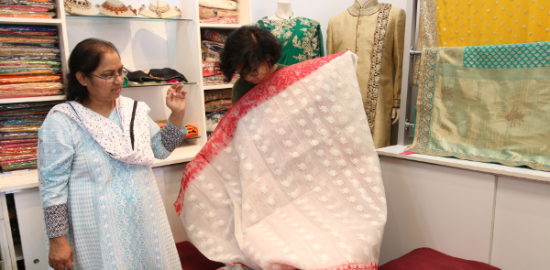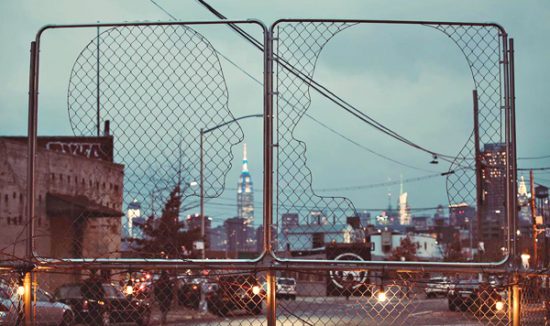When home is a place you’ve never been, can you visit it through objects?
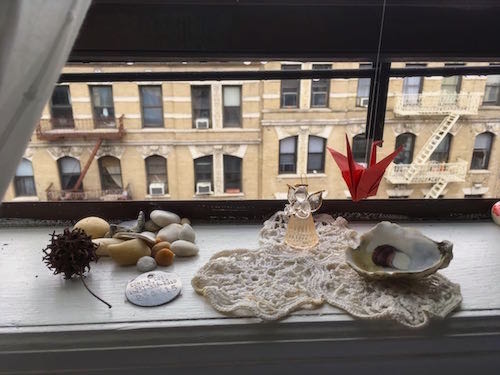
March 16, 2018
My grandmother is always on the side of expired cheese. She runs to the rescue of old clothes and toys, chipped cups and worn out furniture. My family jokes about her inability to throw things away, but we’re hypocrites for laughing. Maybe it’s genetic or a consequence of displacement, but I’ve caught the bug. Every object is a memory that pains me to let go.
In each of the places I have lived, I begin to acquire things, large and small, that tie me to that particular place and time. When I pick up those objects now, I’m transported. Since moving to New York a year ago, I’ve begun my project of collecting once again. When I arrived, my suitcases held not just clothes and books, but things I have no need for but will never throw away – a red paper crane that hangs on a string, a delicate glass angel, an unfinished crochet pattern of three flowers, a small wooden bowl.
As I spend time here, I find myself preserving things that root me to this land, to the ‘here’ of this city: pebbles from long summer days at Jacob Riis Park Beach in the Rockaways, swimming in an unfamiliar ocean; the shell from the first oyster I ever ate, at the Upper West Side’s The Mermaid Inn, slipped under a napkin so no one would notice; the alien-looking spiky seed pods from the sweetgum trees that litter the sidewalks of Harlem in autumn; my roommate’s dog’s old ID tag, with his name and her phone number engraved on it.
Post-its and cards, drawings and notes pile up – silly, temporary things that should be discarded. But I can’t bring myself to do that when, for me, they are the archive of my life laid bare.
If home is a place you’ve never been, that you can’t even imagine, can you still miss it? Can it live on in objects?
When I think about having to leave this city, since my visa doesn’t permit me to make a permanent home here, it pains me to think of all the carefully chosen items that I cannot take with me. To lose my red desk at which I sit to write, to lose the broken lamp held together with duct tape, to lose the kitchen table my roommate and I picked out and loved from the moment we saw it – it feels almost physically painful, like I’m losing a part of me.
Most people here are puzzled by this attachment I have to objects. America seems to have embraced a kind of minimalism as virtue, with magazine articles and trends about de-cluttering your life, replacing old things with new, better versions, and the idea that being free of things is linked to your emotional wellbeing.
In 2014, Mari Kondo’s The Life-Changing Magic of Tidying Up was released, selling 1.5 million copies in the U.S. The central idea of Kondo’s method of de-cluttering is to hold each object and ask yourself whether it sparks joy. If it fails to do so, the object no longer needs to take up space in a home. But what happens when those emotions get more complicated? When you live with a history of loss, the things you are able to keep, to hold on to and cherish – these become the shape of home.
——————
I understand the word ‘dispossession’ when I hear my grandfather on the phone with lawyers. He shuffles through piles of yellowing paper, lease deeds for his family’s land in Yazd. The idea that perhaps the country that he fled from 70 years ago might not be willing to give his home back does not deter him. He draws the layout of his house for me. There was a courtyard in the middle, and on summer nights, the family brought their beds out to the terrace and slept under the stars. My grandfather remembers waking up in the mornings to grapes that dropped from the branches above them. Sometimes in my dreams I’m there with them.
When he came to India, all he had were the clothes he was wearing. The thought makes me so anxious that I have to run my hands across my records, my clothes, the spines of my books. I pick them up and calm myself with their weight, their solid there-ness.
In 1688, Johannes Hofer wrote a medical dissertation on an affliction he coined ‘nostalgia’, from the Greek ‘nostos’, meaning ‘to return home’, and ‘algia’, meaning ‘pain.’ Also known as a hypochondria of the heart, the disease was thought to cause the afflicted to confuse the past and present, making them lose touch with reality altogether. Hofer suggested several cures including leeches, warm hypnotic emulsions, and opium. But the best remedy was to return home, a welcome solution for the Swiss soldiers he was studying in France. I want to ask Hofer if it’s possible to long for something you’ve never had. If home is a place you’ve never been, that you can’t even imagine, can you still miss it? Can it live on in objects?
Objects, it seems, provide both nostalgia as well as a cure. They function as proxies for homes that have been lost.
Summer afternoons in Bombay are especially quiet, a time to rest during the sticky, hot days. The best time to do foozooli. Not quite as polite as ‘curiosity,’ this Persian word means to poke around in someone else’s business. As a kid, I considered myself a pro. I’d creep into my grandmother’s room while she was napping, the only sound coming from the rhythm of the ceiling fan. Her cupboard smelled of moth balls, the promise of treasure – history I could touch.
Sitting cross-legged on the cool tiled floor, I’d take each object out and inspect it before setting it down next to me. There was a collection of cut glass vases, embroidered handkerchiefs, letters, birthday cards, perfume bottles, baby clothes, ties, saris, a cloth bag full of rusted keys, a Parker pen collection, pearls, dresses her mother used to wear, a broken music box, and her father’s hat.
Twenty years later, they’re still there. She has also kept Burda books and crochet magazines from the 1960s that her mother left her, a sewing machine from the 50s, a broken Antonelli organ, a piano whose keys have grown yellow with age, two 60-year-old typewriters, and more than 200 letters from her daughter in Austria. Loose photographs and albums take up an entire dresser. I ask my grandmother why she keeps these things. She says they allow her to remember.
——————
I worry, constantly, about forgetting. I take pictures and write down things people say, save notes and press flowers in books. I’m acutely aware of making my present past, saving things that allow me to travel back through time. My wallet, so heavy it can be used as a weapon, is filled with visiting cards from people I’ve met, currencies from countries I’ve been to, and a drawing my sister made for me when she was five. It’s her, myself, and some penguins.
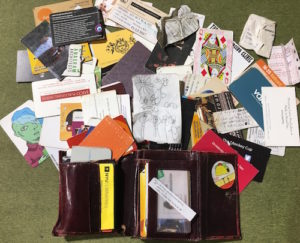
We play games sometimes, my sister and I. There’s “What’s in My Bag?” where she pulls out some ridiculous object I’ve acquired, (like an oversized 5 of diamonds from a magic trick) and I must justify its presence in my bag. Then there’s our favorite, “Remember When.”
“Remember when we used to go to that park and once I said cloud-watching is stupid because every cloud looked like a dinosaur cloud?”
“Remember when we colored on your room walls before we moved out of the old house? And we drew robots and rainbows and then they tore the whole building down?”
“Remember when it was Rusi uncle’s birthday and I beat him at carrom?”
“Rusi uncle died before you were born.”
“Yeah, but I still remember it.”
I muddle my understanding of time the same way my sister does. I forget the different years and circumstances in which my family left Iran, mix up the names of relatives, and can only speak a broken mash-up of Dari and Persian. My memory performs strange temporal acrobatics, timelines folding in on themselves. But objects I understand. Things, yellowed and frayed and eaten by silverfish, are how I come to know home.
Carol Bardenstein proposes the idea of diasporic anachronisms in her paper, “Figures of Diasporic Cultural Production: Some Entries from the Palestinian Lexicon.” She suggests the act of leaving one’s geographical and cultural home results in a falling out of time or out of history. If the understanding of ourselves temporally relies not just on time, but on space, a geographical sense of home, then diaspora disrupts that timeline. Memory freezes home in a certain time, while preserved objects operate as portals, allowing members of the diaspora to exist in different timelines at once.
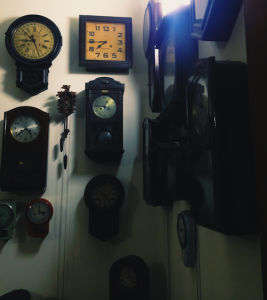
Bardenstein specifically points to common objects like keys to houses that have long been deserted or land deeds that wouldn’t hold up in court, as anachronistic relics of the past made present. Objects, it seems, provide both nostalgia as well as a cure. They function as proxies for homes that have been lost.
In the months before I leave for New York, I lie awake at night in my uncle’s basement in Delhi. Around me, on every wall and table top, antique clocks tick maddeningly. A plastic surgeon by day, my uncle spends his free time buying and fixing timepieces with similar surgical precision. There are over 200 clocks in his collection now, some over a century old. He started at 17 when he noticed an old, broken clock at an Iranian café in Mumbai and asked if he could keep it. The connection to home doesn’t seem coincidental.
Since I can’t sleep, I think about my family’s entanglement with time, with nostalgia, with things. I imagine the detritus of memory as my grandmother’s cupboard, an avalanche of objects tumbling out whenever the doors are opened, each one transporting me to a specific place outside of my present. Upstairs the grandfather clock chimes, and I realize each of the clocks in this limbo basement are wound wrong. Each one tells a different time.

